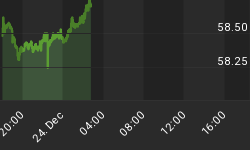
www.CartoonStock.com
Whatever the fundamental or political news are, or even with historical probabilities and odds (heavily) tilt in favor of lower prices over the short-term, the market currently defies all negative odds.
At least two noticeable setups were triggered on close of Friday, February 18, 2011:
- the S&P 500 hit a new high for the year (and a 52-week high as well), and
- closed in the top 20th percentile of the daily trading range on the 7th out of the last 9 sessions,
which historically has had bullish intermediate- and long-term implications in the past.
First of all table I below shows the S&P 500's performance (since 1930), the number of sessions and the maximum gain | loss (drawdown) over the remainder of the year ('Annual Returns') in the event the S&P 500 hit a new high for the year at least once during the week immediately preceding President's Day (celebrated on the 3rd Monday in February since 1971, and celebrated on February 22 before), assumed one went long on close of the session immediately preceding President's Day and went back into cash on close of the last session of the respective year in the past.

Good news for the 'buy and hold' investor. The S&P 500 showed a positive performance (over the remainder of the year) in 23 of those 25 occurrences (years), thereof on all occurrences since 1943, and was lower at the end of the year in 1931 (great depression) and 1937 (shortly before WW II) only. The S&P 500 hit the highest level of the respective year regularly in November or December ('Day of High' greater then 200), while the lowest level of the year was regularly hit somewhere between February and June ('Day of Low' less then 125).
Therefore any sizable pullback from current levels will probably provide a buying opportunity, targeting a close above 1343.01 at the end of 2011.
Table II below shows all historical occurrences and the S&P 500's performance over the course of the then following 1 , 2 , 3 , 6 and 12 months in the event the S&P 500 closed in the top 20th percentile of its daily trading range on the 7th out of the last 9 sessions in the past.

Historically, when late coming buyers in S&P 500 stocks were able to manage an index close near the (intraday) high of the day this often during a short period of time (noticeable that this never happened between 1930 and 1982), the S&P 500 closed at a higher level 3 and 4 months later on 16 out of 18 occurrences, and was lower -1.0+% 3 months later only once, but up +1.0+% on 13 occurrences.
In addition, the S&P 500 closed at a higher level (at least once) exactly 1, 2 or 3 months later on 17 out of those 18 occurrences.
Conclusions:
Eventually the recent run-up in the markets will take its toll and a sizable pullback (living up to its name) will occurr, but this will most probably provide a favorable buying opportunity targeting even higher prices over the intermediate- and longer term.
Successful trading,
And a short reminder: If the information provided is helpful for your own trading business, any donation to my Be it! Children's Charitable Foundation is much appreciated (donations can be sent via PayPal, see widget on the right side of the blog).















